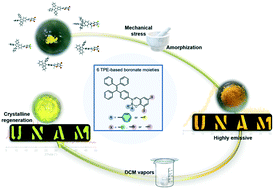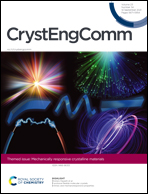The design of dihalogenated TPE monoboronate complexes as mechanofluorochromic crystals†
Abstract
We report here six mechanofluorochromic crystals: three tetraphenylethylene difluoroboronates (–BF2, 3a–c) and three diphenylboronate derivatives (–B(Ph)2, 4a–c) that change emission upon grinding. The corresponding photophysical studies allowed us to identify that most of them show emission in the 500–750 nm range, with the exchange of the –BF2 moiety for the –B(Ph)2 moiety causing an improvement in their quantum yields (Φf). Halogen substitution in their structures caused a decrease of the Φf going from –Cl to –Br to –I. Combining single crystal and powder X-ray analyses, we determined that they are highly crystalline but prone to amorphization via mechanical stress, with a noticeable bathochromic shift of their emission upon grinding. Density functional theory computations indicate that conformational changes upon grinding could cause the observed changes. They undergo reversible changes upon exposure to vapors of dichloromethane, setting the path to develop bistable switches in the future.

- This article is part of the themed collections: Supramolecular & Polymorphism and Mechanically responsive crystalline materials


 Please wait while we load your content...
Please wait while we load your content...